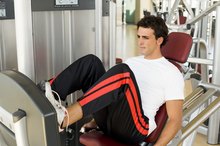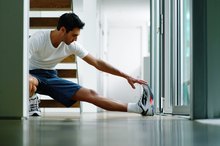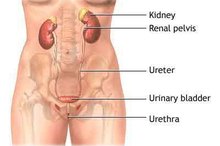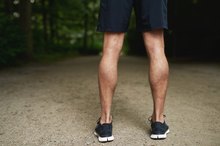What does fact checked mean?
At Healthfully, we strive to deliver objective content that is accurate and up-to-date. Our team periodically reviews articles in order to ensure content quality. The sources cited below consist of evidence from peer-reviewed journals, prominent medical organizations, academic associations, and government data.
The information contained on this site is for informational purposes only, and should not be used as a substitute for the advice of a professional health care provider. Please check with the appropriate physician regarding health questions and concerns. Although we strive to deliver accurate and up-to-date information, no guarantee to that effect is made.
Weightlifting & Abdominal Pain
Pain is your body’s way of telling you something’s not right. Since lifting weights puts a significant amount of strain on the muscles and joints in your body, paying attention to pain – such as abdominal pain – is essential for identifying injury and avoiding worsening whatever is going on with your body 1.
If you are experiencing serious medical symptoms, seek emergency treatment immediately.
Types of Injuries
A number of weightlifting-related injuries are possible, depending on the types of exercises you’re doing. Muscle strains are one of the most common forms of injuries when working out. Muscle strains occur during sharp changes in direction or movement. Hernias develop when you have a weak area of muscle and put strain on the location. A hernia involves an organ – usually an intestine – pushing through weak muscle tissue somewhere in your body, but most often in your abdomen or groin. Besides weak muscles, lifting heavy objects incorrectly can also cause a hernia.
- A number of weightlifting-related injuries are possible, depending on the types of exercises you’re doing.
- A hernia involves an organ – usually an intestine – pushing through weak muscle tissue somewhere in your body, but most often in your abdomen or groin.
Identification of Injury
Flank Pain From a Stretching Tear or Pulled Muscle
Learn More
Identifying your abdominal pain is the first step in treating it so you can get back to working out and building muscle. A muscle strain usually manifests as pain and burning when you contract the specific muscle that was strained. Symptoms of a hernia include a bulge in the area where the hernia occurred, accompanied by pain and sometimes even nausea or vomiting.
Injury Significance
Both hernias and abdominal strains are serious conditions that can keep you out of the weightlifting room for a significant period of time. Depending on the severity of the abdominal strain, you may have to stop lifting weights for up to several weeks to allow it to heal. Some serious hernias require surgery to repair the muscle tissue and put the organ back in its place.
- Both hernias and abdominal strains are serious conditions that can keep you out of the weightlifting room for a significant period of time.
- Depending on the severity of the abdominal strain, you may have to stop lifting weights for up to several weeks to allow it to heal.
Injury Prevention
Hurt Left Side of the Lower Back After Leg Pressing
Learn More
Keeping your abdominal muscles strong and stretched is the key to preventing both a hernia and an abdominal strain. Do a light jog or jumping jacks to get your blood flowing before you start your weightlifting routine. As you lift, make sure you’re using lifting form to prevent a hernia. Lift with your legs if you’re going to be picking up a barbell or other weight set off the floor, and use a weight belt to help support your back as you lift. Avoid jerky movements that are associated with abdominal strains.
- Keeping your abdominal muscles strong and stretched is the key to preventing both a hernia and an abdominal strain.
- Lift with your legs if you’re going to be picking up a barbell or other weight set off the floor, and use a weight belt to help support your back as you lift.
Other Causes of Pain
Just because you feel pain in your abdomen during your workout doesn’t necessarily mean you’ve suffered a serious injury. Your pain could also be due to something as minor as indigestion. If you feel pain, take a break or take the day off from lifting. If pain persists, consult with your doctor.
- Just because you feel pain in your abdomen during your workout doesn’t necessarily mean you’ve suffered a serious injury.
- If you feel pain, take a break or take the day off from lifting.
Related Articles
References
- Sports Injury Clinic: Abdominal Strain
- MedlinePlus: Hernia
- Fitzgibbons RJ, Forse RA. Groin hernias in adults. N Engl J Med. 2015;372(8):756-763. doi:10.1056/NEJMcp1404068
- Merriam-Webster Dictionary. Definition of HARUSPEX. Updated 2020.
- Mahadevan V. Essential Anatomy of the Abdominal Wall. In: Kingsnorth A, LeBlanc K, eds. Management of Abdominal Hernias. Fourth. London: Springer Science & Business Media; 2013:25-55.
- M BS. SRB’s Manual of Surgery. Sixth. London: Jaypee Brothers, Medical Publishers Pvt. Limited; 2019:739-776.
- Wang H, Naghavi M, Allen C, Barber R, Bhutta ZA, Carter A. Global, regional, and national life expectancy, all-cause mortality, and cause-specific mortality for 249 causes of death, 1980–2015: a systematic analysis for the Global Burden of Disease Study 2015. The Lancet. 2016;388(10053):1459-1544. doi:10.1016/S0140-6736(16)31012-1
- Hoffmann H, Walther D, Bittner R, Köckerling F, Adolf D, Kirchhoff P. Smaller inguinal hernias are independent risk factors for developing chronic postoperative inguinal pain (CPIP). Annals of Surgery. 2020;271(4):756-764. doi:10.1097/SLA.0000000000003065
- Dhua AK, Aggarwal SK, Mathur N, Sethi G. Bilateral congenital diaphragmatic hernia. APSP J Case Rep. 2012;3(3):20. PMID: 23061036
Writer Bio
James Patterson specializes in health and wellness topics, having written and produced material for the National Institutes of Health, the President's Cancer Panel and an Inc. 500 Hall of Fame company. He is also a former sportswriter with writing experience in basketball, baseball, softball, golf and other popular sports.








